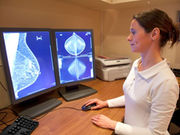Double reporting in radiological investigations generally increases sensitivity, reduces specificity
THURSDAY, March 24, 2016 (HealthDay News) — Double reporting, which refers to the interpretation of radiological investigations by two observers with arbitration and consensus used to settle discordant reports, seems efficacious and cost-effective, especially for mammography, according to a review published online March 21 in the Journal of Medical Imaging and Radiation Oncology.
Richard E. Pow, M.B.B.S., from the University of Sydney, and colleagues conducted a systematic review to examine the evidence relating to the effect of double reporting on diagnostic efficacy in various imaging domains. Data were included from 41 studies that met inclusion criteria relating to diagnostic efficacy, of which 23 studies related to mammography. In addition, two systematic reviews and/or meta-analyses were discussed.
The researchers note that double reporting is a validated method of reducing error, and it generally increases sensitivity and reduces specificity. As such it is most useful where emphasis is placed on high sensitivity, for example in cancer screening where early detection offers significant benefit and missing lesions may have serious consequences. The most efficacious and cost-effective strategy is independent double reporting with arbitration or consensus review of discordant reports.
“Most of the research to date has occurred within mammography,” the authors write. “Attention should now turn to other common examinations, particularly since widespread implementation of digital imaging eases the implementation of this effective error-reducing technique.”
Copyright © 2016 HealthDay. All rights reserved.








